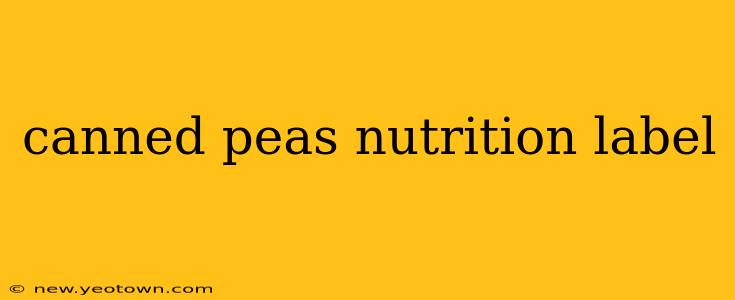Decoding the Canned Pea Nutrition Label: A Surprisingly Nutritious Story
Let's be honest, canned peas aren't exactly the most glamorous food item. They often conjure up images of childhood dinners and perhaps a slightly metallic aftertaste. But tucked inside those humble cans is a surprisingly nutritious powerhouse, packed with vitamins, minerals, and fiber. Understanding the nutrition label can help you appreciate just how much this often-overlooked vegetable contributes to a healthy diet. Let's peel back the layers (pun intended!) and explore the nutritional information found on a typical canned pea label.
What are the main nutritional components of canned peas?
A typical serving of canned peas (around ½ cup) boasts a surprisingly impressive nutritional profile. You'll find a good source of Vitamin K, essential for blood clotting and bone health. They're also a decent source of Vitamin A, crucial for vision and immune function, and Vitamin C, a powerful antioxidant. Furthermore, canned peas contribute to your daily intake of folate (important for cell growth and development), manganese (involved in bone health and metabolism), and iron (essential for oxygen transport). The fiber content helps with digestion and keeps you feeling full, contributing to weight management.
How do the nutrients in canned peas compare to fresh peas?
This is a common question, and the answer is nuanced. While fresh peas generally contain slightly higher levels of certain vitamins and minerals, the nutritional difference between canned and fresh peas isn't drastically significant. The canning process does cause some nutrient loss, primarily water-soluble vitamins like Vitamin C, but the overall nutritional value remains substantial. The convenience factor often outweighs the minor nutritional differences for many consumers. Plus, canned peas are often available year-round, regardless of the growing season.
Are canned peas a good source of protein?
While not a primary protein source like meat or beans, canned peas do contribute a modest amount of protein to your diet. They are considered a good source of plant-based protein, valuable for vegetarians and vegans. The protein content, while not enormous, adds to the overall nutritional value and helps contribute to satiety.
What are the potential downsides of eating canned peas?
One potential downside is the sodium content. Many canned peas contain added salt, which can be a concern for individuals with high blood pressure or those on low-sodium diets. Always check the nutrition label and opt for low-sodium or no-salt-added varieties whenever possible. Additionally, some individuals might find the texture slightly less appealing compared to fresh peas. The canning process can slightly alter the firmness and overall taste.
How can I incorporate canned peas into my diet?
Canned peas are incredibly versatile. Beyond the classic side dish, you can add them to soups, stews, salads, pasta dishes, or even blend them into smoothies for a boost of nutrients. Their mild flavor makes them a great addition to various culinary creations, adding both flavor and nutrition. Think pea and ham soup, creamy pea pasta, or even a vibrant pea and mint salad. The possibilities are endless!
Are there any health risks associated with consuming canned peas?
Generally, canned peas are safe for consumption. However, individuals with specific allergies or sensitivities should always check the ingredient list for potential allergens. As mentioned before, the high sodium content in some brands might be a concern for individuals with specific dietary restrictions. Choosing low-sodium options mitigates this risk. Furthermore, like any canned food, it’s important to ensure proper storage to prevent spoilage.
In conclusion, the humble canned pea, often overlooked, offers a surprising array of nutritional benefits. By understanding the nutritional label and choosing low-sodium options, you can easily incorporate this convenient and healthy vegetable into your diet. Its versatility and year-round availability make it a valuable asset in any kitchen.

